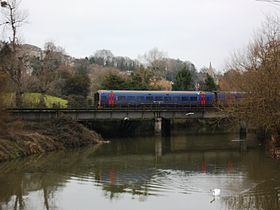Status Operational | ||
 | ||
Type Suburban rail, Heavy rail Locale WiltshireHampshireSouth East EnglandSouth West England Track gauge 1,435 mm (4 ft 8 ⁄2 in) standard gauge | ||
Wessex main line southampton central to salisbury 159 008
The Wessex Main Line is the railway line from Bristol Temple Meads to Southampton. Diverging from this route is the Heart of Wessex Line from Westbury to Weymouth. The line intersects with the West of England Main Line at Salisbury, and with the Reading to Taunton Line at Westbury.
Contents
- Wessex main line southampton central to salisbury 159 008
- Bridge over wessex main line near lidl supermarket in trowbridge 25 07 2015
- Places served
- Chippenham branch
- Southampton to Salisbury
- North of Salisbury
- Across Salisbury
- 20th century
- References
Bridge over wessex main line near lidl supermarket in trowbridge 25 07 2015
Places served
The places served are listed below.
Passenger services are currently operated by Great Western Railway local services, supplemented by South West Trains between Salisbury and Bristol Temple Meads, and Great Western high-speed express services between Bristol and Bath. Some services start at Swindon also. Many services continue beyond Southampton along the West Coastway Line to Portsmouth Harbour and Brighton, and beyond Bristol to Severn Tunnel Junction, Newport and Cardiff Central along the South Wales Main Line. Strong passenger growth meant that Wessex Trains increased train lengths from two carriages to three in 2004, but the new franchise specification reduced them back to two carriages, with inevitable chronic overcrowding and passenger protests. As of 2011, the service now regularly runs with three carriages, but significant overcrowding continues at peak times.
Chippenham branch
There is a link from Trowbridge to Chippenham, with an intermediate stop at Melksham. Despite showing strong passenger growth in the previous few years, the new franchise reduced services in December 2006 to two each way per day, at times barely convenient for commuters. The service was increased again to eight trains each way per day (six northbound and five southbound on Sundays) from December 2013.
Southampton to Salisbury
The South Western Main Line of the London and Southampton Railway, which changed its name to the London and South Western Railway in 1839, had reached Southampton in 1840. A branch to Salisbury (Midford) from a junction on the main line at Eastleigh (then called Bishopstoke) was opened in 1847. The branch passes through Romsey and the Dean valley; today part of its route forms the Eastleigh-Romsey line.
A more direct route between Southampton and Romsey was adopted in 1865 on completion of the Sprat and Winkle Line (at first by the Andover and Redbridge Railway, but taken over by the LSWR before completion). This forms the current route of the Wessex Main Line: departing westbound from Southampton Central via Millbrook and Redbridge before branching north to Romsey.
North of Salisbury
The line through Wiltshire and Somerset was completed in stages, after the Wilts, Somerset and Weymouth Railway (WS&WR) was authorised by Parliament in 1845. The first section to be opened, in 1848, ran from Thingley junction to the west of Chippenham on the Great Western Railway, via Melksham and Trowbridge to Westbury. The WS&WR company was unable to fund further construction, and in 1849 the directors decided to sell their line to the GWR.
The GWR's branch to Salisbury from Westbury was completed through the Wylye valley in 1856, with the first section, as far as Warminster, having been opened in 1851.
The route from a junction near Staverton, north of Trowbridge, to Bradford-on-Avon had been constructed in 1848 but the rails were not laid. This branch, via Bradford then along the Avon valley to join the GWR main line at Bathampton, was completed in 1857.
Across Salisbury
Further work was required at Salisbury to complete the Bristol-Southampton route, as the GWR station was in the west of the city at Fisherton, about 1 mile (1.6 km) away from the earlier LSWR station at Milford on the southeast side. In 1857 the LSWR's West of England line (London-Exeter via Basingstoke and Andover) arrived in northeast Salisbury, at first using the Midford station. In 1859 the LSWR opened a new station at Fisherton, immediately south of the GWR station, to serve two lines: the Andover line, which had been extended across the city, and the new Salisbury and Yeovil Railway towards Exeter. The Milford station was then closed to passengers.
A transit shed was opened between the two Fisherton stations in 1860, to allow goods to be transferred between the GWR's broad gauge wagons and the LSWR's standard gauge. Following the conversion of the GWR to standard gauge in 1874, a connecting siding was built in 1878 to allow shunting of wagons. A direct route for passengers came into use with the inauguration of a Cardiff to Portsmouth service in 1896.
20th century
At Salisbury, the LSWR station (which had been expanded in 1878) was further expanded and remodelled, with a large extension to the station building completed in 1902. The GWR station continued to be used by branch services until it was closed to passengers in 1932; it was used as a goods depot until 1991 and is now part of Salisbury Traincare Depot. Milford continued as a major goods depot until 1967.
Westbury station was rebuilt in 1899 to cater for the Stert and Westbury Railway, opened 1900, which now forms part of the Reading-Taunton line.
On the Chippenham branch, the halts at Beanacre and Broughton Gifford closed in 1955. The smaller stations on the Salisbury branch – Heytesbury, Codford, Wylye and Wilton North – closed to passengers in the same year, although in most cases goods service continued into the 1960s. In Hampshire, Nursling station closed in 1957.
Bathampton and Limpley Stoke stations closed in 1966. The same year saw closure of the remaining local stations on the Chippenham branch: Lacock Halt, Holt (along with the entire Devizes branch) and Staverton Halt.
